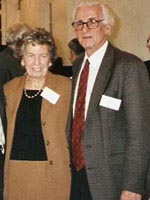 Egle Laufer, who worked with her husband Moe at the Brent Adolescent Centre, and who co- wrote their major book, Adolescence and Developmental Breakdown, brought a specific focus to the theoretical and clinical significance of the body, in particular, to the girl’s adaptation to the adult feminine body.
Egle Laufer, who worked with her husband Moe at the Brent Adolescent Centre, and who co- wrote their major book, Adolescence and Developmental Breakdown, brought a specific focus to the theoretical and clinical significance of the body, in particular, to the girl’s adaptation to the adult feminine body.
Born in Vienna, her interest in psychoanalysis was part of a family culture, her mother part of leftwing cultural revolution in Vienna following the defeat of Austria after the great war, which included some of the same people that had attracted the interest of the young Anna Freud. Egle moved to England at the age of 7, so she did not reside for long in the Viennese world occupied by Sigmund and Anna Freud, and her intellectual allies, concerned with adolescence: Aichorn, Bernfield, Blos and Ericson. But finding herself professionally at a loss after doing a maths degree in university, she was encouraged by her psychiatrist mother to read Aichorn’s Wayward Youth, eventually a point of connection, not entirely conscious, between Anna Freud, Moe Laufer, and Egle, who would become his wife.
Unlike Moe, Egle did not train as a child psychoanalyst with Anna Freud. Her special interests in psychoanalysis grew out of work she did with women, not children. Her own sense of the importance of transitional moments in the evolution of personality derived from early work in the department of obstetrics at University College Hospital, where an approach to post partum psychosis in women was based on the theory that women who were vulnerable to post partum psychosis could be identified before partuation: a form of treatment was devised aimed at preventing this breakdown, the breakdown itself understood in terms developed at the Cassel hospital.
As Egle Laufer has written, the focus in this work was on the relationship between mother and baby, the understanding being that the breakdown that was taking place was located in the relationship between mother and baby, rather than the breakdown understood as a psychotic illness in the mother, requiring hospitalization for the mother alone, and thus separation from the baby. (Laufer 2009) In this approach, there is something of the same focus as that which informed the theory of adolescent breakdown.
In this work with women, before she became involved with Moe Laufer and adolescence, Egle Laufer focuses on a specifically feminine relationship to change, and a breakdown in the ego’s capacity to accept becoming a mother. As pregnancy progresses, the dissociation from the body in the mind of the prospective mother marks a move away from reality, the greater the move away, the more traumatic and unacceptable the reality of the birth. The more the birth is experienced as a trauma, the more likely the predisposition to psychotic functioning.
This early work with women informed Egle Laufer’s role at the Brent Adolescent Center where she was one of the founding members. She emphasized the difference between the girl’s and the boy’s evolution, the different experiences of the changing adolescent body, the different relationships to masturbation in adolescent boys and girls.
She would write an influential paper on the girl’s experience of masturbation in adolescence, exploring the links between the masturbation, and the adolescent girl’s ambivalent relationship to her mother, identifying the masturbation with defensive denial of hostility and disappointment with the mother from whom she must separate.
Here, Egle Laufer shows a characteristic interest in integrating thoughts on early relationships to the primary object and the body, understanding the adolescent struggle evolving out of earlier, infantile experience. Her emphasis here is slightly different from that of Moe Laufer, she showing more interest and confidence in relating the adolescent experience to the early relationship to the mother, mindful always of the complexity of the tensions between separation and identification in the adolescent process, particularly for the girl.
Sara Flanders 2015
